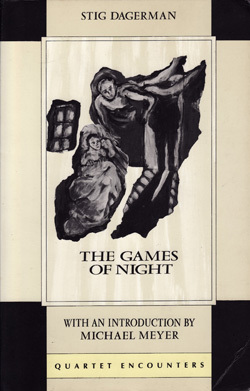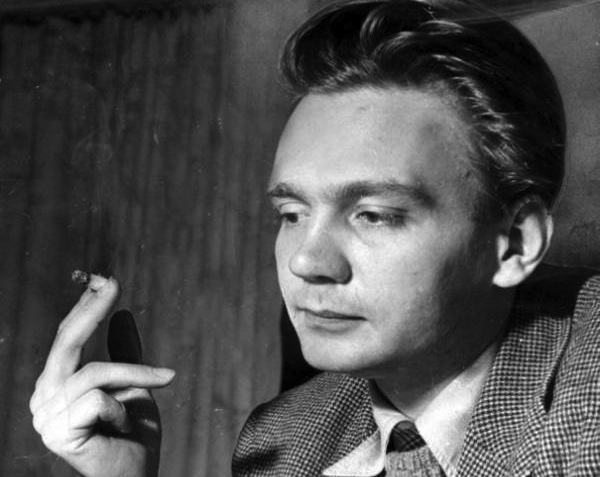
photo by Anders Wahlbom
The 2013 THRESHOLDS International
Short Story Feature Writing Competition Runner-up:
Dan Powell
*
Comments from the judging panel:
‘We get fascinating insights throughout this piece. The parallels between Dagerman’s life and his stories reveal, very poignantly, the urgency and sense of necessity that fuelled them’; ‘a compelling essay about an author I had not come across before but whom I now very much want to get to know’; ‘sharp, sophisticated and absorbing’; ‘tender yet unsentimental – I had to read on.’
*
Stig Dagerman’s The Games of Night
by Dan Powell
I first read The Games of Night while holidaying on a stretch of Scandinavian coastline, Danish rather than Swedish. Yet the rolling farmland, outlined by the thin sweep of single-lane tarmac roads and dotted with huddled villages, resonated with the rural Swedish landscapes described in Stig Dagerman’s stories. Standing outside the holiday home, the sea before me, the farmland behind, the only sound the steady murmur of the waves, and surrounded by the sort of deep, illuminated night that only descends in places without streetlights, it was easy to inhabit rural narratives like ‘A Child’s Memoir’, ‘Where’s My Iceland Jersey?’ and ‘Sleet’.
The tension Dagerman’s characters feel when torn from their rural origins and dragged by necessity into the towns and cities is one the author felt only too acutely when, at the age of fourteen, he was torn from his happy home with his grandparents and forced to live in the capital with a father who was almost a stranger to him:
The farmers’ children regarded me as a Stockholm boy, an intruder … In Stockholm I was the clodhopping yokel.
No surprise then that many of the stories – ‘Where’s My Iceland Jersey?’ and ‘Open the Door, Richard’ most notably – explore this tension through the prism of characters struggling to adapt when forced to move from one setting to another or back again.
 Sometimes at night, running from the shadows of his own loneliness, Stig Dagerman had a game he would play. As the dark of the evening sky thickened, he would walk the streets of Stockholm until he found himself inside the track hall of Central Station. Anonymous amidst the churning crowds, he pretended he could wish himself anywhere. On those evenings, on those nights, there was only one place to wish oneself, and so he would reach a hand to his pocket hoping to find a ticket to China there, a ticket he might one day show when the police came to move him on, as they always did. What China would look like he did not know. But it would not be Stockholm and it would not be now and he, perhaps, would not be so alone. As he considered all of this, the police would appear and ask to see the ticket he did not have.
Sometimes at night, running from the shadows of his own loneliness, Stig Dagerman had a game he would play. As the dark of the evening sky thickened, he would walk the streets of Stockholm until he found himself inside the track hall of Central Station. Anonymous amidst the churning crowds, he pretended he could wish himself anywhere. On those evenings, on those nights, there was only one place to wish oneself, and so he would reach a hand to his pocket hoping to find a ticket to China there, a ticket he might one day show when the police came to move him on, as they always did. What China would look like he did not know. But it would not be Stockholm and it would not be now and he, perhaps, would not be so alone. As he considered all of this, the police would appear and ask to see the ticket he did not have.
In the title story of The Games of Night, Stig Dagerman gives his child protagonist the ultimate ticket: the ability to move through space by thought alone. ‘The Games of Night’ are the games Åke plays in the darkness as he listens to his mother crying. His drunken father props up some bar across town, surrounded by a host of equally drunken cronies who appear, to Åke at least, to hold his father prisoner. Åke’s main game, like Dagerman’s, is to imagine himself invisible and able to travel anywhere he wishes. For this sensitive young boy ‘there is only one place to wish oneself’ and so he moves invisibly across Stockholm to where his father sits drinking.
The story takes the shape of a series of attempts by the invisible Åke to guide his father home. He leads him into a taxi and whispers his address into the ear of the cabbie. He puts him on a tram and rides with him a short way before wishing himself home. In one particularly brutal scene, the boy imagines using an invisible knife to murder his father’s drunken captors, in a desperate bid to free him. The games come to an end deep in the night when the father finally arrives home, and the reality of his drinking and abuse become all too clear. The next afternoon, Åke, sent to the pub to ask his father for money, is forced to play the game for real, and the reality of the child’s impotence is exposed in the tender and subtle tragedy of the story’s climax. It is no accident that this story, suffused with the brightness of a child’s imagination and shadowed by the stark realities of life with an alcoholic, is the title story. This balance of light and dark is a key tonal feature of Dagerman’s short fiction.
Before his nightly visits to Central Station, when Stig Dagerman was sixteen and living in Stockholm with his father, he heard that his grandfather had been murdered by a madman. He had lived with his grandparents in a small farmhouse outside Ålvkarleby – a hundred miles north of the capital – for the first fourteen years of his life, seeing his father only rarely and his mother never. His grandmother died from shock a few weeks after her husband’s murder. The evening Stig Dagerman heard the news of his grandfather’s death, he took himself to Stockholm’s City Library and tried to write a poem to the dead man’s memory, finally tearing up the few pitiful lines he managed to scratch onto the paper, ashamed at their inadequacy. In the opening autobiographical fragment of The Games of Night, ‘A Child’s Memoir’, he writes:
But out of that shame, out of that impotence and grief, something was born – something which I believe was the desire to become a writer; that is to say, to be able to tell of what it is to mourn, to have been loved, to have been left lonely.
It is these themes that permeate his short fiction; stories told through the eyes of a young male protagonist brought up on a farm owned by his grandparents, before moving, in adolescence, to the city to live with his working-class parents. This is deeply personal fiction that manages, through its grappling with such universal themes, to transcend the limits of its own specificity.
‘A Child’s Memoir’ brims with the love and respect Dagerman felt for the grandparents who took him in when his mother and father abandoned their responsibility. Then the shadow of grief at his grandparents’ death descends, leaving Dagerman forever exiled from that time and place. When he writes of knowing then ‘beyond all doubt what I must be. I must be a writer. And I knew what I must write: the book of my dead’, this revelation, earned through tragic experience, seems cold consolation. It is easy to view The Games of Night as a book of the dead, filled as it is with absence. His characters all suffer loss of one kind or another, they all struggle, and in its darkness one might perhaps argue that Dagerman is a writer who conforms to the dark, existential stereotype of the Scandinavian writer, were it not for the light that is found in the corners of even his darkest stories.
 These are also stories so mired in their landscape that they do more than simply capture a lost pastoral vision of rural Sweden; they take on an almost mythic quality, the setting becoming a battlefield on which the rural and the urban, as well as light and darkness, do battle. This aspect of his work is most explicit in the bedroom farce of ‘Men of Character’, in which a forester and a city-educated schoolteacher are forced into conflict by the teacher’s adulterous wife. Dagerman infuses the story with a gravitas far beyond the melodrama of the subject matter, pitching the story of the cuckolded schoolteacher perfectly between comedy and tragedy. It is perhaps here that he owes his greatest debt to Chekhov.
These are also stories so mired in their landscape that they do more than simply capture a lost pastoral vision of rural Sweden; they take on an almost mythic quality, the setting becoming a battlefield on which the rural and the urban, as well as light and darkness, do battle. This aspect of his work is most explicit in the bedroom farce of ‘Men of Character’, in which a forester and a city-educated schoolteacher are forced into conflict by the teacher’s adulterous wife. Dagerman infuses the story with a gravitas far beyond the melodrama of the subject matter, pitching the story of the cuckolded schoolteacher perfectly between comedy and tragedy. It is perhaps here that he owes his greatest debt to Chekhov.
He returns to this conflict between town and country throughout the collection: in the cold realisation of what those who leave are forced to abandon in ‘Where’s My Iceland Jersey?’, in the bittersweet remembrance of days gone in ‘Sleet’, and in the dark satire of ‘Nocturnal Resort’. But these are more than simply exercises in nostalgia. Beneath the humour and keen descriptions of his prose is darkness, and the harsh adage that one can never go home is a truism that Dagerman struggled with in both his fiction and his life.
Perhaps the keenest example of this is the funereal ‘In Grandmother’s House’. As with Åke in the ‘The Games of Night’, this story begins with the imaginative leap of a child. This time, in the sunlight of a country day, the boy imagines his dead Grandfather as living in the sun, smiling down on them when it shines, sad when the clouds obscure the sky, crying with the rain. Playing with his grandfather’s boots, the small boy climbs inside one of them, lost for a while in visions of jumping and stomping across gardens and fields and into the woods. It is a moment of childish magic that is shattered when he becomes stuck in the boot and rips it while escaping. His childish attempts to keep his grandmother from discovering the crime, reveals to the reader a deep-seated grief that the boy can only describe as a silence squatting over the house. Dagerman’s depictions of a child’s world colliding abruptly with the adult world are, understandably considering his past, a crucial feature of his short works.
This collision is shown in its most abrupt and most literal form in ‘To Kill a Child’. A stark, cautionary tale, commissioned as part of a road safety awareness campaign, the story is a powerful, moment by moment account of the build up to, and immediate aftermath of, an all too believable road accident – involving a couple, as they enjoy a Sunday morning drive, and a small boy sent to run an errand at just the wrong moment. The story hangs on the dark inevitability of what the reader sees coming from the very beginning. The opening idyllic description of villages set along a stretch of country road is soon shattered by the line: ‘It was the happy morning of an evil day, for on this day a child was to be killed in the third village, by a happy man.’ The reader is compelled to watch the story unfold, fearful of what is about to happen yet unable to look away. Such is the power of the story that it is a fixture on school reading lists in Sweden and even forms part of drivers’ education.
In 1954, having completed four plays, four novels, a book of reportage and his remarkable collection of short work, The Games of Night, and leaving behind his wife of only sixteen months, Stig Dagerman gassed himself in the garage of his house. His short fiction does not make for easy reading. Like the man himself, his stories are pained and dark and compelling, but there are bright corners too, illuminated by the hope and innocence of child-like imagining.
Like all great short fiction, these stories defy our efforts to paraphrase them. The Games of Night, like their author, are complex, their rewards deep yet ultimately intangible. These imaginative, humane stories are elusive but not illusory and, like all great work, they come alive most truly in the process of reading and re-reading. There is darkness here, but, as with life, there is also light. The Games of Night are games worth playing.


3 thoughts on “The Games of Night”
Comments are closed.